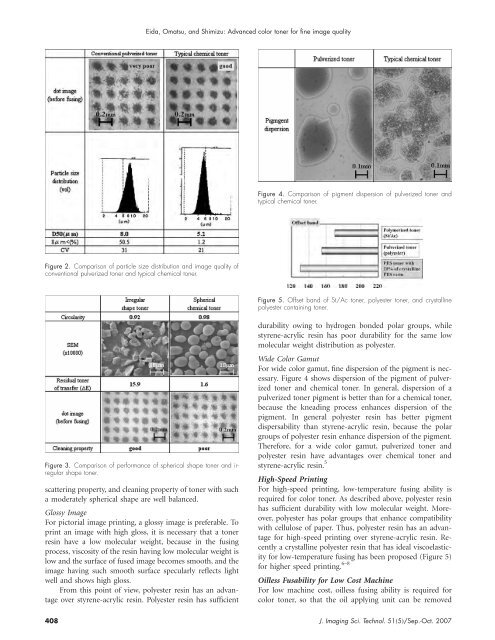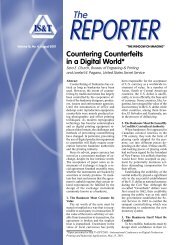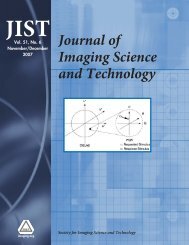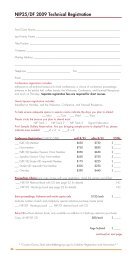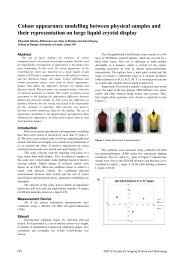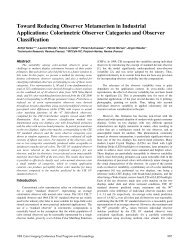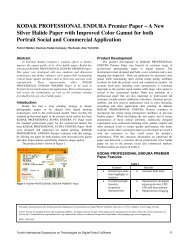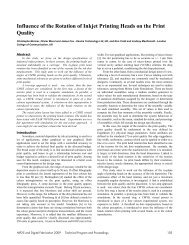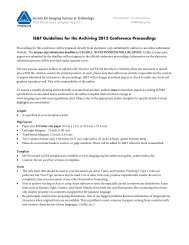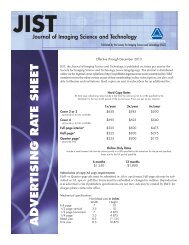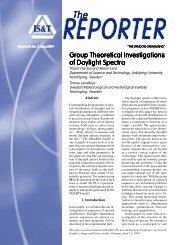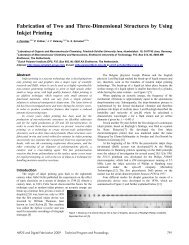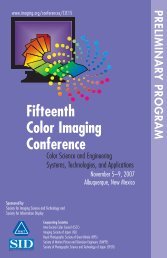JIST - Society for Imaging Science and Technology
JIST - Society for Imaging Science and Technology
JIST - Society for Imaging Science and Technology
You also want an ePaper? Increase the reach of your titles
YUMPU automatically turns print PDFs into web optimized ePapers that Google loves.
Eida, Omatsu, <strong>and</strong> Shimizu: Advanced color toner <strong>for</strong> fine image quality<br />
Figure 4. Comparison of pigment dispersion of pulverized toner <strong>and</strong><br />
typical chemical toner.<br />
Figure 2. Comparison of particle size distribution <strong>and</strong> image quality of<br />
conventional pulverized toner <strong>and</strong> typical chemical toner.<br />
Figure 5. Offset b<strong>and</strong> of St/Ac toner, polyester toner, <strong>and</strong> crystalline<br />
polyester containing toner.<br />
Figure 3. Comparison of per<strong>for</strong>mance of spherical shape toner <strong>and</strong> irregular<br />
shape toner.<br />
scattering property, <strong>and</strong> cleaning property of toner with such<br />
a moderately spherical shape are well balanced.<br />
Glossy Image<br />
For pictorial image printing, a glossy image is preferable. To<br />
print an image with high gloss, it is necessary that a toner<br />
resin have a low molecular weight, because in the fusing<br />
process, viscosity of the resin having low molecular weight is<br />
low <strong>and</strong> the surface of fused image becomes smooth, <strong>and</strong> the<br />
image having such smooth surface specularly reflects light<br />
well <strong>and</strong> shows high gloss.<br />
From this point of view, polyester resin has an advantage<br />
over styrene-acrylic resin. Polyester resin has sufficient<br />
durability owing to hydrogen bonded polar groups, while<br />
styrene-acrylic resin has poor durability <strong>for</strong> the same low<br />
molecular weight distribution as polyester.<br />
Wide Color Gamut<br />
For wide color gamut, fine dispersion of the pigment is necessary.<br />
Figure 4 shows dispersion of the pigment of pulverized<br />
toner <strong>and</strong> chemical toner. In general, dispersion of a<br />
pulverized toner pigment is better than <strong>for</strong> a chemical toner,<br />
because the kneading process enhances dispersion of the<br />
pigment. In general polyester resin has better pigment<br />
dispersability than styrene-acrylic resin, because the polar<br />
groups of polyester resin enhance dispersion of the pigment.<br />
There<strong>for</strong>e, <strong>for</strong> a wide color gamut, pulverized toner <strong>and</strong><br />
polyester resin have advantages over chemical toner <strong>and</strong><br />
styrene-acrylic resin. 5<br />
High-Speed Printing<br />
For high-speed printing, low-temperature fusing ability is<br />
required <strong>for</strong> color toner. As described above, polyester resin<br />
has sufficient durability with low molecular weight. Moreover,<br />
polyester has polar groups that enhance compatibility<br />
with cellulose of paper. Thus, polyester resin has an advantage<br />
<strong>for</strong> high-speed printing over styrene-acrylic resin. Recently<br />
a crystalline polyester resin that has ideal viscoelasticity<br />
<strong>for</strong> low-temperature fusing has been proposed (Figure 5)<br />
<strong>for</strong> higher speed printing. 6–8<br />
Oilless Fusability <strong>for</strong> Low Cost Machine<br />
For low machine cost, oilless fusing ability is required <strong>for</strong><br />
color toner, so that the oil applying unit can be removed<br />
408 J. <strong>Imaging</strong> Sci. Technol. 515/Sep.-Oct. 2007


